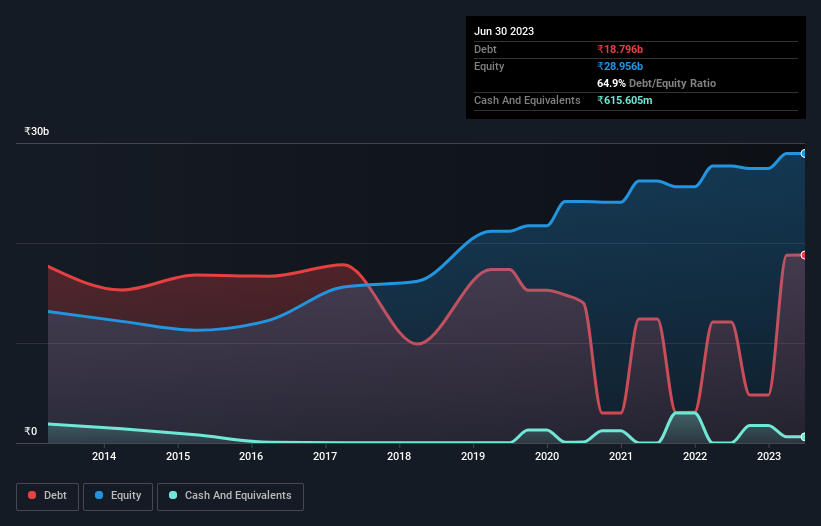Is Balrampur Chini Mills (NSE:BALRAMCHIN) Using Too Much Debt?

The external fund manager backed by Berkshire Hathaway's Charlie Munger, Li Lu, makes no bones about it when he says 'The biggest investment risk is not the volatility of prices, but whether you will suffer a permanent loss of capital.' So it might be obvious that you need to consider debt, when you think about how risky any given stock is, because too much debt can sink a company. We note that Balrampur Chini Mills Limited (NSE:BALRAMCHIN) does have debt on its balance sheet. But the real question is whether this debt is making the company risky.
When Is Debt Dangerous?
Generally speaking, debt only becomes a real problem when a company can't easily pay it off, either by raising capital or with its own cash flow. If things get really bad, the lenders can take control of the business. While that is not too common, we often do see indebted companies permanently diluting shareholders because lenders force them to raise capital at a distressed price. Of course, plenty of companies use debt to fund growth, without any negative consequences. The first step when considering a company's debt levels is to consider its cash and debt together.
View our latest analysis for Balrampur Chini Mills
What Is Balrampur Chini Mills's Net Debt?
As you can see below, at the end of March 2023, Balrampur Chini Mills had ₹18.8b of debt, up from ₹12.1b a year ago. Click the image for more detail. However, it does have ₹615.6m in cash offsetting this, leading to net debt of about ₹18.2b.

A Look At Balrampur Chini Mills' Liabilities
We can see from the most recent balance sheet that Balrampur Chini Mills had liabilities of ₹19.6b falling due within a year, and liabilities of ₹5.69b due beyond that. Offsetting these obligations, it had cash of ₹615.6m as well as receivables valued at ₹1.33b due within 12 months. So it has liabilities totalling ₹23.4b more than its cash and near-term receivables, combined.
This deficit isn't so bad because Balrampur Chini Mills is worth ₹83.5b, and thus could probably raise enough capital to shore up its balance sheet, if the need arose. But it's clear that we should definitely closely examine whether it can manage its debt without dilution.
We measure a company's debt load relative to its earnings power by looking at its net debt divided by its earnings before interest, tax, depreciation, and amortization (EBITDA) and by calculating how easily its earnings before interest and tax (EBIT) cover its interest expense (interest cover). This way, we consider both the absolute quantum of the debt, as well as the interest rates paid on it.
With net debt to EBITDA of 2.9 Balrampur Chini Mills has a fairly noticeable amount of debt. On the plus side, its EBIT was 7.4 times its interest expense, and its net debt to EBITDA, was quite high, at 2.9. Notably Balrampur Chini Mills's EBIT was pretty flat over the last year. We would prefer to see some earnings growth, because that always helps diminish debt. There's no doubt that we learn most about debt from the balance sheet. But it is future earnings, more than anything, that will determine Balrampur Chini Mills's ability to maintain a healthy balance sheet going forward. So if you're focused on the future you can check out this free report showing analyst profit forecasts.
Finally, while the tax-man may adore accounting profits, lenders only accept cold hard cash. So we clearly need to look at whether that EBIT is leading to corresponding free cash flow. In the last three years, Balrampur Chini Mills created free cash flow amounting to 11% of its EBIT, an uninspiring performance. That limp level of cash conversion undermines its ability to manage and pay down debt.
Our View
Balrampur Chini Mills's struggle to convert EBIT to free cash flow had us second guessing its balance sheet strength, but the other data-points we considered were relatively redeeming. For example, its interest cover is relatively strong. Looking at all the angles mentioned above, it does seem to us that Balrampur Chini Mills is a somewhat risky investment as a result of its debt. Not all risk is bad, as it can boost share price returns if it pays off, but this debt risk is worth keeping in mind. The balance sheet is clearly the area to focus on when you are analysing debt. However, not all investment risk resides within the balance sheet - far from it. For instance, we've identified 2 warning signs for Balrampur Chini Mills that you should be aware of.
Of course, if you're the type of investor who prefers buying stocks without the burden of debt, then don't hesitate to discover our exclusive list of net cash growth stocks, today.
Valuation is complex, but we're here to simplify it.
Discover if Balrampur Chini Mills might be undervalued or overvalued with our detailed analysis, featuring fair value estimates, potential risks, dividends, insider trades, and its financial condition.
Access Free AnalysisHave feedback on this article? Concerned about the content? Get in touch with us directly. Alternatively, email editorial-team (at) simplywallst.com.
This article by Simply Wall St is general in nature. We provide commentary based on historical data and analyst forecasts only using an unbiased methodology and our articles are not intended to be financial advice. It does not constitute a recommendation to buy or sell any stock, and does not take account of your objectives, or your financial situation. We aim to bring you long-term focused analysis driven by fundamental data. Note that our analysis may not factor in the latest price-sensitive company announcements or qualitative material. Simply Wall St has no position in any stocks mentioned.
About NSEI:BALRAMCHIN
Balrampur Chini Mills
Engages in the manufacture and sale of sugar in India.
Reasonable growth potential and fair value.
Market Insights
Community Narratives



